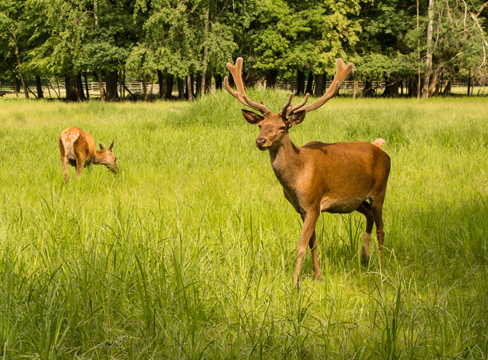 White-tailed deer are a big and growing business worth more than $3 billion annually in Texas, and interest in this remarkable natural resource increases each year. While the average Texas producer may have difficulty with their cash flow from the livestock enterprise, many have realized profits from deer hunting operations. A key element to successful deer management is a population that is in balance with the habitat and forage supply. Although native habitat management is important, many managers are choosing to provide introduced forages during times when native plants may be absent or low in nutritive value. A wildlife forage area or food plot may contribute to the overall quality of the managed herd, or can be a costly educational experience if sound agronomic procedures are not implemented. This publication discusses the establishment and management of forages suitable for white-tailed and exotic deer.
White-tailed deer are a big and growing business worth more than $3 billion annually in Texas, and interest in this remarkable natural resource increases each year. While the average Texas producer may have difficulty with their cash flow from the livestock enterprise, many have realized profits from deer hunting operations. A key element to successful deer management is a population that is in balance with the habitat and forage supply. Although native habitat management is important, many managers are choosing to provide introduced forages during times when native plants may be absent or low in nutritive value. A wildlife forage area or food plot may contribute to the overall quality of the managed herd, or can be a costly educational experience if sound agronomic procedures are not implemented. This publication discusses the establishment and management of forages suitable for white-tailed and exotic deer.
What Does a Deer Eat?
White-tailed deer are ruminants like cows, but their diet selection is radically different. Cattle are grass-roughage eaters, have a relatively large rumen relative to body size, and depend heavily on grasses for their diet. Warm-season perennial grasses are relatively low in crude protein and digestibility when compared with legumes or forbs (broadleaf weeds). Because of these nutritive parameters, grasses have a longer residence time in the cow rumen. Longer residence time increases rumen microflora (bacteria and protozoa) degradation of the forage. Thus for grass-roughage consumers like cattle and sheep, residence time is relatively long and rate of passage slow.
White-tailed deer are concentrate selectors. Their rumen is small relative to body size; thus, their diet must be higher in nutritive value and more rapidly degraded in the rumen. Therefore, white-tailed deer rely primarily on forbs and browse (leaves and twigs of woody plants), which are usually higher in crude protein and digestibility than grasses. Warm-season perennial grasses comprise only a very small part of the overall diet of the white-tailed deer. Only grasses that are rapidly degraded in the rumen, such as the cool-season annual small grains and ryegrass, are used to any extent by deer. Other useful introduced forages include both warm- and cool-season annual legumes. Native plants used by white-tailed deer include browse, forbs, soft and hard mast (fruits, acorns), and mushrooms. Forbs and mast, while providing good nutrition, may not be available each year or at all times of the year. Browse is usually the most important source of deer nutrition because of year-round availability.
NOTE: Warm-season perennial grasses that supply cattle with most of their nutrients will not meet the nutrient and consumption requirements of white-tailed deer. Therefore, most forages planted for deer will include either forage legumes or cool-season annual grasses.
Where in the State are You?
Texas is a diverse state, both from a climatic and soils perspective. The state may be divided into vegetational areas (Fig. 1) based on similarities in temperature, moisture, and soils. These vegetational areas include the following, as identified by Gould (1975):
1. Pineywoods
2. Gulf Prairies & Marshes
3. Post Oak Savannah
4. Blackland Prairies
5. Cross Timbers & Prairies
6. South Texas
7. Edwards Plateau
8. Rolling Plains
9. High Plains
10. Trains-Pecos, Mountains, & Basins
Forage sustainability and adaptability are environment and site specific. While the main limiting factor to forage production is usually moisture, many plants are sensitive to temperature extremes, and others are intolerant of acid soils and require lime to increase soil pH for establishment and persistence. It is important to understand the unique soil and climatic requirements for forage species of interest and select only those that can persist at the wildlife forage area or food plot location.
For additional assistance in determining which specific forages will work in your vegetational area, contact your local County Extension Agricultural Agent and refer to Fig.1 and Tables 1 and 2.
Establishment Guidelines
Below is a checklist of important factors to consider when contemplating forage establishment for white-tailed deer.
- Objective: Reasons to establish forages usually involve supplementation of deer during times when forage quantity and/or nutritive value is low. Cost-efficient and biologically effective supplementation can only be accomplished by understanding the seasonal nutritive requirements of white-tailed deer. A food plot could also be used as an attractant to enhance opportunities for inventory, harvesting, photography, or simply observing.
- Forage adaptation: By considering the following five topics, one can determine if certain forages are adapted to the area of interest and are able to produce enough forage to be considered economically viable. This all-important initial determination will save time, money, and frustration.
- Soil type(s) and fertility: Site selection is critical to successful wildlife forage establishment and production. Determine beforehand if there is an acceptable site capable of supporting forage growth. Consider carefully the soil type at the establishment site and whether or not the site is subject to drought, flood, or erosion. Obtain a soil analyses from the site(s) to insure successful establishment of these annual forages and especially legumes.
Moisture availability during the establishment and growing seasons: There is a distinct moisture gradient that transects from east to west in Texas. Check long-term precipitation records, periods of drought, etc. to increase the success potential of forage establishment. The importance of timely planting and good seedbed preparation are the best insurance against crop failure due to deficient moisture.
Temperature extremes: Many forage plants are sensitive to cold weather. Plants that persist for years in South Texas may not survive the first freeze event in North Texas. By the same token, some plants are intolerant of the extreme heat that can be experienced in South Texas and the Edwards Plateau. Ensure that the forages chosen will persist in the vegetational region of interest.
Forage palatability and acceptance: It matters not that the plant is adapted and produces great quantities of dry matter if the deer will not consume the plant. White- tailed deer are very selective in what they eat. Although consumption preferences exist for deer, cattle, people, etc., the forages listed in Tables 1 and 2 are accepted by white-tailed and exotic deer, sheep, goats, cattle, and horses.
Forage availability for deer: White-tailed deer generally need supplemental nutrition during late summer through late winter when native forages may be lacking in quantity or nutritive value. Thus, the growth cycle of forages should be considered. Spring-planted, warm-season annual forages generally provide nutrition from June through September. Fall-planted, cool- season annual forages usually have forage available from November through April. Depending on the location and the forage, the planted area may provide valuable nutrition in a timely manner. If the forage does not offer nutrition when it is needed (i.e., stress periods), there may be little point to establishment and maintenance of those species.
Once the above aspects have been considered and the decision made to plant, consider the following checklist to maximize the potential for successful establishment of a wildlife forage area or food plot.
- Select an appropriate site based on forage species requirements. Avoid excessively wet or dry sites. Size of the planted area will depend on intended use (attractant, supplement, etc.) and the size of the managed property. Some authorities recommend planting 2% of the total acreage when supplementing deer. Plant to maximize “edge” effect; i.e., long, narrow forage sites will increase the edge effect compared to square sites.
- Soil test and apply needed lime well in advance of planting. Lime with an ECCE of 100 has the most rapid buffering capacity. If required, phosphorus (P) and potassium (K) should be incorporated into the clean-tilled seedbed. If sod-seeding, surface-apply lime well in advance of planting, and apply P and K prior to or at planting. Apply nitrogen to small grain or ryegrass after greenup. Do not use N with legumes as this may encourage grassy weed competition.
- Check seed availability and cost. Seed is a relatively inexpensive component of the overall cost of establishment; therefore, purchase seed with a guaranteed analysis for pure live seed, weed seed, hard seed, etc. Besides excellent nutritional value, legumes provide their own nitrogen and do not need N fertilziation. In order for nitrogen fixation to occur, legumes require inoculation with specific Rhizobia bacteria. If a legume is to be planted, make sure inoculant is available. Be sure to follow the inoculation procedure to optimize legume production or purchase pre- inoculated seed.
- Sod-seeded or clean tilled? In east Texas, cool-season annual forages can be successfully established into warm-season perennial grass sods if certain establishment procedures are followed. In other cases, clean-tilled seedbeds usually provide more forage, but may not be an option due to equipment availability.
- Begin preparing seedbed in anticipation of planting. Several trips across the field may berequired to prepare the final clean-tilled seedbed. Allow adequate time for possible delays due to weather, equipment failure, etc. Keep the seedbed in a fallow (no plants growing) condition to conserve moisture at the site. If sod-seeding, make sure the warm- season perennial grass is grazed or mown very short prior to planting.
- Locate equipment required for establishment. Locate equipment or custom operator well in advance of the planting date. If someone else establishes the forage area, make sure they understand the species, timing, seeding rate, etc. Write it down! This minimizes misunderstandings about forage establishment.
- Plant quality seed at the proper rate to the proper depth at the proper time into a moist seedbed when possible.
- Surface-apply additional nitrogen midway through the growing season for small grain or ryegrass (usually 50 lbs/ac).
- Be alert for insects or weeds that may require pesticide application.
For more information on forage planting for deer, click here.
Source: Wildlife Forage Areas and Food Plots for Deer
Larry A. Redmon
Texas AgriLife Extension Service, College Station
Monte Rouquette, Jr.
Texas AgriLife Research, Overton
